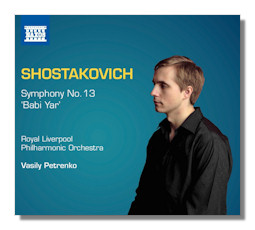
The Internet's Premier Classical Music Source
Related Links
- Shostakovich Reviews
- Latest Reviews
- More Reviews
-
By Composer
-
Collections
DVD & Blu-ray
Books
Concert Reviews
Articles/Interviews
Software
Audio
Search Amazon
Recommended Links
Site News
 CD Review
CD Review
Dmitri Shostakovich

Symphony #13 in B Flat minor "Babi Yar", Op. 113
Alexander Vinogradov, bass
Men's Voices of the Huddersfield Choral Society
Men's Voices of the Royal Liverpool Philharmonic Choir
Royal Liverpool Philharmonic Orchestra/Vasily Petrenko
Naxos 8.573218 60min
This is the concluding volume in Vasily Petrenko's Shostakovich symphony cycle. In six previous reviews here I have covered eight symphonies from this generally highly praised Naxos series: 2 & 15 (Naxos 8.572708), 6 & 12 (Naxos 8.572658), 7 (Naxos 8.573057), 8 (Naxos 8.572392), and 10 (Naxos 8.572461). They all achieved success to one degree or other, and this new CD is among the finest performances in the series.
For those who may not know, Babi Yar in the title of this symphony refers to the famous and once controversial Yevgeny Yevtushenko poem (controversial in the Soviet Union at least) condemning the anti-Semitism rampant in Russia for many years. Although the symphony was never actually banned, it was viewed suspiciously from its 1962 premiere by Soviet officials who demanded and got temporary changes in the Yevtushenko text, changes which Shostakovich never officially entered into the score. The poem is set in the first movement, while four other Yevtushenko poems (Humor, In the Store, Fears, and A Career) are set in the remaining four movements. In any event, Shostakovich had taken quite a chance setting Babi Yar to music, but in the end received high praise for his effort, especially in the West. Shostakovich had been in good standing with the Soviets because of his then-recent Symphony #12, subtitled "The Year 1917", which depicts key events in the Bolshevik Revolution in a positive, even heroic manner.
That placation of the Soviet arts administrators takes nothing from the Symphony #13, which stands as a monument of protest and as one of the composer's greatest and boldest works. Its chilling drama and sense of both tragedy and irony come across here so powerfully in this extraordinary performance. First, the playing by the Royal Liverpool Philharmonic and singing by bass soloist Alexander Vinogradov are first rate, as are the vocal performances of the Royal Liverpool Philharmonic Choir and the Huddersfield Choral Society. Petrenko has to take much of the credit though, because as usual he is insightful throughout the score, pointing up essential detail, obtaining proper vocal and instrumental balances and selecting tempos that always work nicely. But what he achieves best of all is capturing the generally dark moods inherent in Shostakovich's music here. Try the utterly bleak but intense fourth movement, subtitled "Fears". You almost feel the fear; feel the shudders in the mostly quiet but rumbling and always threatening music. Here the tuba soloist effectively captures the dark character of the music, music which seems to recall the Prelude to Act II of Wagner's Siegfried. Petrenko allows the opening of the seemingly brighter finale, subtitled A Career, to offer a brief sense of repose but goes on to capture the biting ironies ahead most deftly: listen to the phrasing of the main theme when it returns midway through on pizzicato strings with a seemingly nervous or unsure gait. And then listen to that same theme at the symphony's end, where its now sad and desolate character emerge in splendidly subtle phrasing and dynamics.
There have been many excellent recordings of this symphony, including the briskly paced and brilliantly conceived first one, famously made by Kirill Kondrashin, who also led the premiere performance. This one by Petrenko may well rival that superb effort – it's that good. Naxos provides vivid sound reproduction, full texts and informative notes by Richard Whitehouse. For admirers of Shostakovich and those interested in 20th-century symphonic and choral music, this is a most attractive issue. Strongly recommended.
Copyright © 2014, Robert Cummings




















